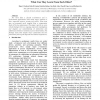50 search results - page 1 / 10 » What can we learn from noncoding regions of similarity betwe... |
BMCBI
2004
13 years 5 months ago
2004
Background: In addition to known protein-coding genes, large amounts of apparently non-coding sequence are conserved between the human and mouse genomes. It seems reasonable to as...
BMCBI
2005
13 years 5 months ago
2005
Background: NemaFootPrinter (Nematode Transcription Factor Scan Through Philogenetic Footprinting) is a web-based software for interactive identification of conserved, non-exonic ...
HICSS
2009
IEEE
14 years 1 days ago
2009
IEEE
For more than a decade e-Commerce and eGovernment applications have made major impacts in their respective sectors, private and public. Some time ago, we presented early insights ...
BMCBI
2010
13 years 5 months ago
2010
Background: While most multiple sequence alignment programs expect that all or most of their input is known to be homologous, and penalise insertions and deletions, this is not a ...
BMCBI
2011
12 years 8 months ago
2011
Background: Comparison of the human genome with other primates offers the opportunity to detect evolutionary events that created the diverse phenotypes among the primate species. ...

